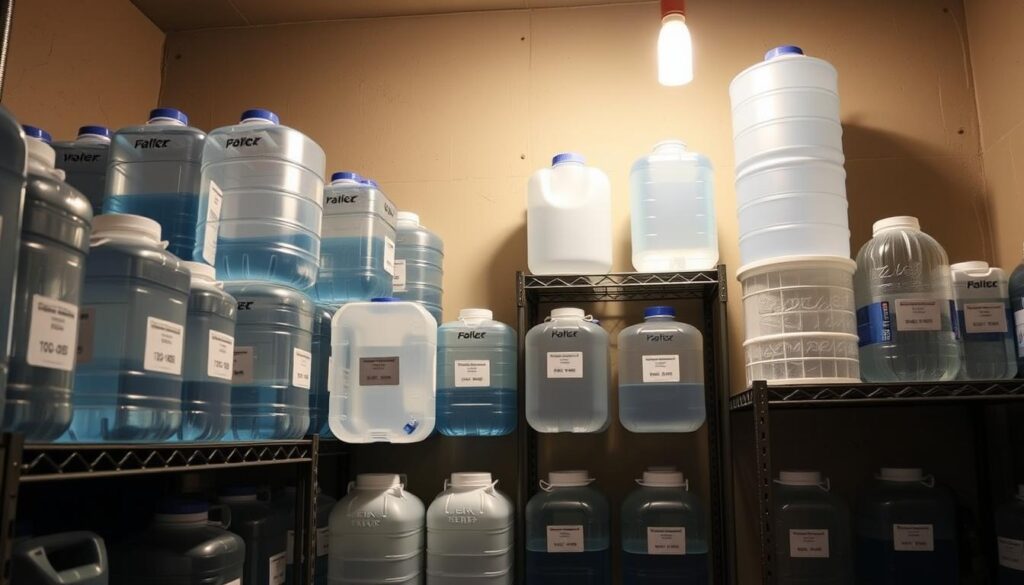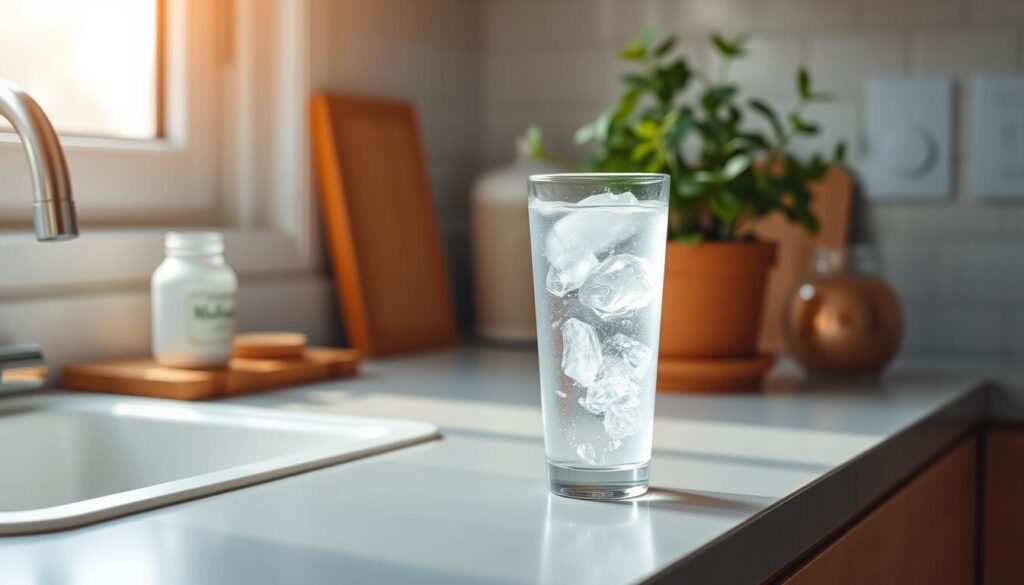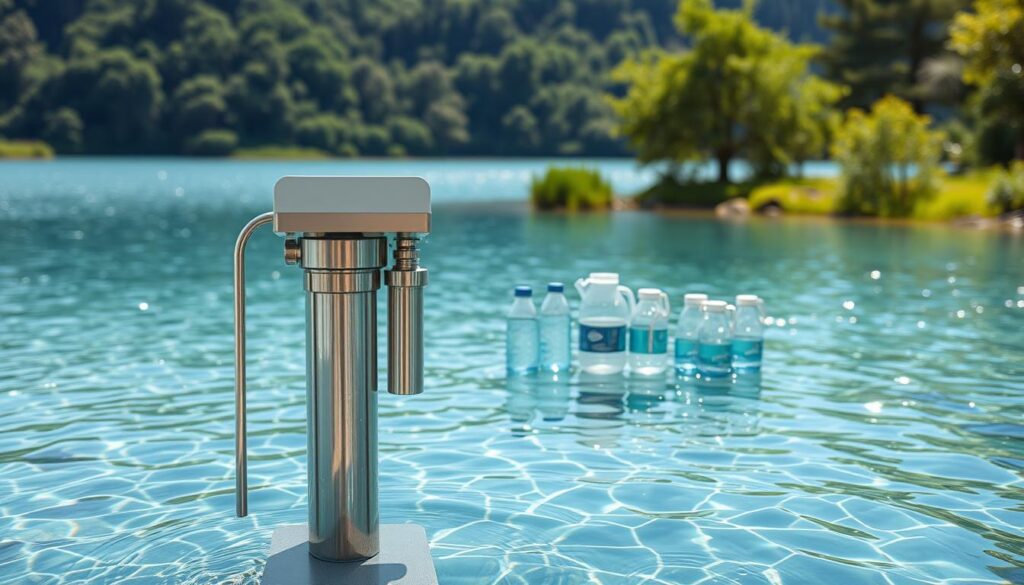Thinking about emergencies makes me realize how key reliable water storage is for my family’s safety. The American Red Cross and FEMA say we should have 1 gallon of water per person per day for 3-14 days. It might seem hard, but a good water storage system is essential during disasters.
In this guide, I’ll show you why storing water in containers is important. I’ll also help you pick the best plastic water containers or other solutions for your needs.
Key Takeaways
- Store at least 1 gallon of water per person per day for 3-14 days.
- Choose the right water storage containers based on material, size, and local regulations.
- Regular inspection and cleaning of water storage systems are vital.
- Consider factors like durability and rust-resistance when selecting a water tank.
- Water quality testing is necessary to ensure stored water is safe for use.
Understanding the Importance of Water Storage
Water storage is key to being ready for emergencies. It’s often overlooked. Having clean water is vital for survival during disasters or crises.
Storing water is not just about having enough for drinking. It’s also for cooking, hygiene, and health. We’ll look at why water storage matters and when you need it.
Why Storing Water is Essential
Storing water ensures a steady supply, even when usual sources fail. The phrase “Water is life” highlights its importance. Having a reliable storage system can mean the difference between being ready and being caught off guard.
Experts say you should have at least one gallon of water per person per day. For a family of four, that’s 120 gallons for three days.
Types of Situations Requiring Water Storage
Several situations call for water storage. This includes natural disasters like hurricanes, earthquakes, and floods. Also, water supply disruptions due to failures or contamination require stored water.
Some specific situations include:
- Natural disasters such as hurricanes, earthquakes, and floods
- Water supply disruptions due to infrastructure failures or contamination
- Extended power outages or other emergencies that may impact water treatment facilities
Understanding water storage’s importance helps keep your family safe during crises.
Choosing the Right Water Storage Container
When picking a water storage container, think about a few key things. The right one can really help with storing water effectively.
Material Options: Plastic, Glass, and Metal
There are a few materials to choose from: plastic, glass, and metal. Each has its own good and bad points.
- Plastic Containers: They’re light, strong, and not too pricey. But, make sure they’re safe for food to avoid harmful chemicals.
- Glass Containers: Glass is safe and doesn’t mix with chemicals. But, it’s heavy and can break easily.
- Metal Containers: Metal, like stainless steel, is tough and good for storing water. Just make sure it’s safe for food and coated to stop rust.
A study on water storage safety says, “Choosing the right material for your containers is key to keeping water clean and safe.”
“The material of the container can significantly affect the quality of the stored water.”
| Material | Advantages | Disadvantages |
|---|---|---|
| Plastic | Lightweight, durable, affordable | Potential for chemical leaching if not food-grade |
| Glass | Non-toxic, doesn’t leach chemicals | Heavy, prone to breakage |
| Metal | Durable, can be made from food-grade materials | Potential for corrosion if not properly coated |
Size Considerations for Different Needs
The size of your container depends on your needs. For everyday use, 1 to 5 gallons is usually enough. For emergencies, you might need bigger or more containers.
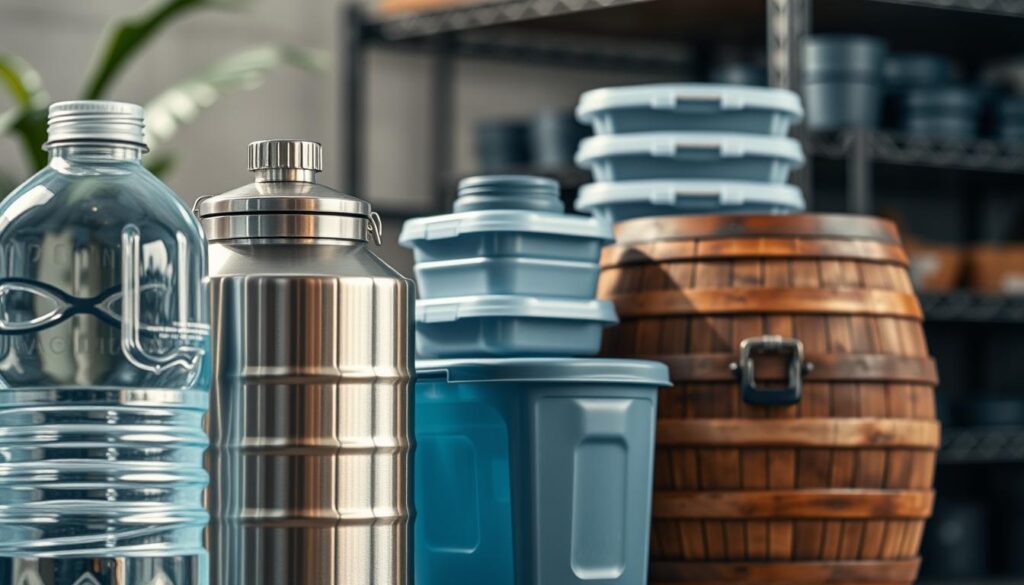
Additional Features to Look For
Other things to think about include:
- Spigot or Tap: A spigot makes it easier to pour water and keeps it clean.
- Collapsible Design: Collapsible containers save space when not in use.
- Handles: Handles make it easier to carry, even when full.
By looking at these points, you can pick a container that fits your needs and keeps your water safe and easy to get to.
How to Properly Clean Water Storage Containers
Cleaning your water storage containers is key to keeping water safe. It stops harmful bacteria and viruses from getting in. This makes sure the water is good to drink.
Steps for Cleaning Before Use
To clean your containers before use, follow these steps:
- Empty the container completely.
- Wash it with soap and warm water. Use a soft-bristled brush to clean off any dirt.
- Rinse it well with clean water to get rid of soap.
- Sanitize it with a mix of 1 teaspoon of unscented bleach per quart of water. Let it sit for 30 minutes before rinsing.

Recommended Cleaning Solutions
The best cleaners for water containers are mild dish soap and unscented bleach. Stay away from harsh chemicals. They can harm the water or the container.
| Cleaning Agent | Purpose | Precautions |
|---|---|---|
| Mild Dish Soap | General Cleaning | Rinse thoroughly to remove soap residue. |
| Unscented Bleach | Sanitizing | Use 1 tsp per quart of water. Rinse after 30 minutes. |
By following these steps and using the right cleaners, you can keep your containers clean and safe. This ensures your drinking water stays pure.
Best Practices for Filling Water Storage Containers
Filling water storage containers needs careful attention to keep the water safe. It’s important to follow best practices to keep the water quality high.
Using Safe Water Sources
The first step is to use safe water sources. This includes tap water that meets EPA standards or treated water from a reliable source.
Choosing safe water sources is key to the water’s quality. I recommend checking your local water utility’s quality report to make sure it’s safe.
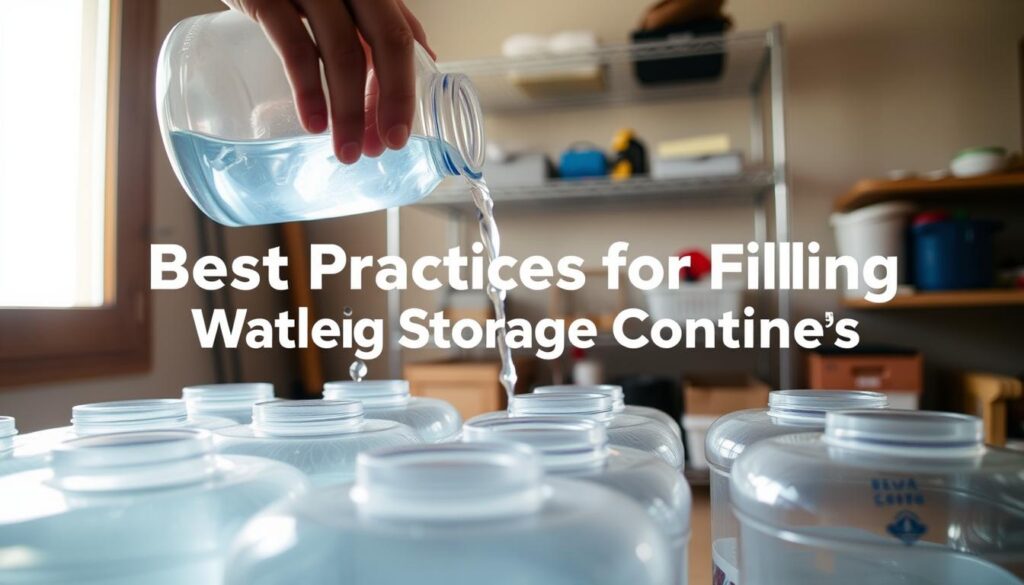
Avoiding Contamination During Fill-Up
It’s also important to avoid contamination during filling. This means handling containers and equipment in a way that prevents contamination.
To reduce contamination risk, follow these steps:
- Ensure the container and equipment are clean and sanitized before use.
- Fill the container in a clean environment, away from contamination sources.
- Use a dedicated filling hose or equipment designed for potable water.
By following these guidelines, you can greatly reduce contamination risk during filling.
| Best Practice | Benefit |
|---|---|
| Using safe water sources | Ensures the stored water is safe for consumption |
| Avoiding contamination during fill-up | Prevents the introduction of contaminants into the stored water |
| Regularly inspecting containers and equipment | Helps identify and address issues before they become major problems |
Where to Store Water Storage Containers
To keep your stored water safe and fresh, it’s vital to choose the right storage location for your containers. The storage location plays a significant role in maintaining the quality of the stored water.
Ideal Locations in Your Home
When deciding where to store your water containers, consider locations that are cool, dark, and away from direct sunlight. Avoid storing water containers near heating vents, radiators, or appliances that generate heat, as high temperatures can affect the water quality and the container’s integrity.
Basements or cellars are often ideal for storing water containers because they tend to be cooler and darker than other areas of the home. If you don’t have a basement, consider storing them in a closet or pantry that is not exposed to direct sunlight.
Managing Temperature and Light Exposure
Temperature and light exposure are critical factors in maintaining the quality of stored water. It’s recommended to store water containers at a consistent temperature between 50°F and 70°F (10°C and 21°C). Avoid areas that are prone to freezing or extreme heat fluctuations.
As noted by water storage experts, “Storing water in a cool, dark place helps to prevent the growth of algae and bacteria, ensuring the water remains safe to drink.”
“Proper storage conditions are critical for maintaining water quality over time.”
To manage light exposure, keep containers away from windows and use opaque containers or cover clear containers with a cloth or box to block out light. This will help prevent algae growth inside the containers.
By carefully selecting the storage location for your water containers and managing temperature and light exposure, you can ensure that your stored water remains safe and fresh for use in emergencies or daily consumption.
Recommended Brands of Water Storage Containers
Finding the best water storage container can be tough without knowing the top brands. There are many options in the market. It’s key to pick brands known for quality, durability, and function.
Top Brands for Home Use
For home use, some brands really stand out. ReliaSoft is known for its tough portable water tanks great for home needs. Water Storage Solutions also offers water barrels for safe and efficient storage.
A review on The Prepared shows these brands get high praise for their products.
Specialty Options for Emergency Preparedness
For emergency prep, some brands focus on emergency water storage. AquaSafe is known for its strong, reliable containers for emergencies.
Experts say, “The right water storage gear is key for handling emergencies well.” (
A well-prepared person has a plan and the tools to carry it out.
>AquaSafe is at the forefront in providing these critical tools.
How to Determine Water Storage Capacity
To be ready, figuring out how much water you need is key. You must know your household’s needs and plan for emergencies.
Calculating Your Needs Based on Household Size
Start by figuring out how much water your family uses daily. A good rule is one gallon per person for drinking, cooking, and cleaning. For a family of four, that’s four gallons a day. But, your needs can change based on your climate, activity level, and more.
If you live in a hot area or have active family members, you might need more water. Don’t forget about your pets and any extra water for gardening or outdoor activities.
Here’s a simple formula to calculate your household’s daily water needs:
- Number of people in the household x 1 gallon (for basic needs)
- Add extra gallons for hot climate or high activity levels
- Consider additional needs for pets and outdoor uses
Planning for Emergencies and Extended Use
It’s also important to plan for emergencies and longer uses. The American Red Cross suggests storing water for at least three days. But, aim for up to two weeks in case of disasters.
“Having an adequate supply of water is one of the most critical components of emergency preparedness.” –
Think about the disasters that could hit your area and how they might affect your water. For example, if you live where earthquakes happen, you might need more water because of possible water service breaks.
For longer uses, think about the size and quality of your water containers. Choose ones that are BPA-free, strong, and made for long-term storage.
Maintenance Tips for Long-Term Water Storage
Regular checks and maintenance are key to keeping your water storage containers clean and safe. It’s important to watch both the water and the containers closely. This way, your stored water stays good to drink for a long time.
Regular Checks for Contamination or Damage
It’s vital to check your water storage containers often for any signs of trouble. Look for cracks, rust, or leaks that could harm the container and the water inside. Also, watch out for sediment, algae, or strange smells that might mean contamination.
Inspection Steps:
- Check the container’s exterior and interior for any damage or contamination.
- Verify that the lid or cap is secure and not damaged.
- Inspect the water for any visible signs of contamination.
How Often to Replace Stored Water
Experts usually say to replace stored water every 6 to 12 months. But, how often you need to do this can change based on a few things. These include the storage conditions, the type of container, and how well you take care of it.
Factors Influencing Replacement Frequency:
- The material of the container (e.g., plastic, glass, or metal).
- The storage environment (e.g., temperature, light exposure).
- The initial quality of the water.
By checking your stored water and containers often, and replacing the water when needed, you can have a steady supply of safe drinking water.
Frequently Asked Questions About Water Storage
Storing water can raise many questions. I’ll cover some common ones to help you understand the best ways to store water. This includes troubleshooting any problems you might face.
Addressing Common Concerns
Many think any container can hold drinking water. But, it’s important to use only safe containers. These should be made from food-grade plastic or glass.
Common issues like contamination or damaged containers can happen. Regular checks and proper cleaning can solve these problems.
Troubleshooting Tips
Problems like off-tastes or odors in stored water can be a challenge. First, check the container’s cleanliness and the water source. Make sure your containers are sealed well and kept in a cool, dark place.
For more detailed advice, look at resources from trusted groups on emergency preparedness and water safety.
FAQ
What type of water storage containers are best for emergency preparedness?
For emergency prep, use durable, BPA-free plastic containers or collapsible tanks. They’re easy to move and store. Reliance Products and Coleman are good brands.
How often should I clean my water storage containers?
Clean your containers every 6-12 months, or when needed. Use mild detergent and warm water. Rinse well to avoid contamination.
Can I store water storage containers in my garage or attic?
No, don’t store them in garages or attics. These places have extreme temperatures that can harm water quality. Keep them in a cool, dark spot like a basement or pantry.
How do I determine the right water storage capacity for my household?
Calculate your daily water use and multiply by household size. Aim for at least one gallon per person per day for drinking, cooking, and hygiene.
Are collapsible water containers a good option for long-term water storage?
Collapsible containers are okay for emergencies but not for long-term. They might get damaged or contaminated. For long-term, use rigid containers or barrels.
Can I use a water storage container that has been stored for a long time?
Check containers for damage or contamination before use. If damaged or contaminated, replace it. If not, sanitize it well before using.
What are some common mistakes to avoid when storing water?
Avoid using non-food-grade containers, storing in direct sunlight, and not sanitizing regularly. These steps help keep your water safe and clean.

